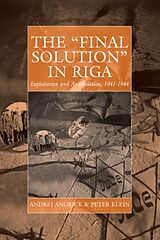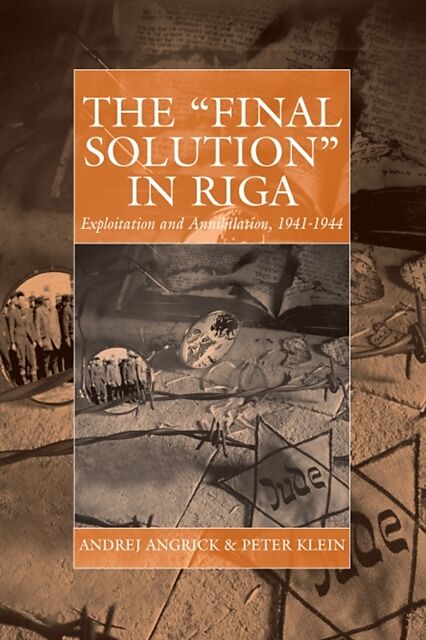The 'Final Solution' in Riga
Einband:
Fester Einband
EAN:
9781845456085
Untertitel:
Exploitation and Annihilation, 1941-1944
Genre:
Geschichte
Autor:
Andrej Angrick, Peter Klein, Ray Brandon
Herausgeber:
Ingram Publishers Services
Anzahl Seiten:
530
Erscheinungsdatum:
01.11.2009
ISBN:
978-1-84545-608-5
Zusatztext NOMINATED FOR THE RAPHAEL LEMKIN AWARD BY THE INSTITUTE FOR THE STUDY OF GENOCIDE "With its ?[over thousand] detailed and expansive footnotes drawing on twenty-four different archive collections in eight countries and three continents and an enormous secondary literature! this is one of the best researched regional studies of the Holocaust ever to appear. It is helped by the fact that the authors are also always so cognizant of what was happening elsewhere in Europe at the same time and thus frequently draw out the relationship between seemingly haphazard local decisions and trends across Europe?Indeed! the way in which the book 'makes sense' of complex institutional behavior is at times breathtaking?The precision in the detail and the scope of the contextualization make this one of the more important works to appear on the Holocaust in recent years." ? English Historical Review "Translated flawlessly from German into English by Ray Brandon! [this] readable and engaging study eminently meets the series ' high standards of scholarship. Its 17-page bibliography lists old classics as well as the most recent publications! and the copious! annotated endnotes following each chapter constitute a parallel book in themselves. Although the authors rely heavily on the much-researched Federal Republic archives! they also introduce materials that became accessible only with the collapse of the Eastern Bloc and the Soviet Union itself." ? European History Quarterly "This very readable and well documented study fills an important gap in the Holocaust literature: it offers insight into the microcosm reflecting the entire terrifying and murderous scenario of the SS State." ? Frankfurter Allgemeine Zeitung "[This] excellent study of the Riga ghetto! informed by Eastern European sources and available now in English translation! provides a precise and ghastly description of what [the liquidation] meant for the local Jews. With laudable thoroughness! they describe the organized shooting of Jews! the first form of industrial-scale mass murder." ? The New York Review of Books Informationen zum Autor Andrej Angrick , a native of Berlin, is a historian, consultant, and researcher affiliated with the Hamburg Foundation for the Promotion of Science and Culture. He has published numerous articles about the Holocaust in the Soviet Union and co-edited Der Dienstkalender Heinrich Himmlers 1941/42 (1999) and Die Gestapo nach 1945: Karrieren, Konflikte, Konstruktionen (with Klaus-Michael Mallmann, 2009), as well as Besatzungspolitik und Massenmord: Die Einsatzgruppe D in der südlichen Sowjetunion 1941-1943 (2003). Klappentext Ghetto, forced labor camp, concentration camp: All of the elements of the National Socialists' policies of annihilation were to be found in Riga. This first analysis of the Riga ghetto and the nearby camps of Salaspils and Jungfernhof addresses all aspects of German occupation policy during the Second World War. Drawing upon a broad array of sources that includes previously inaccessible Soviet archives, postwar criminal investigations, and trial records of alleged perpetrators, and the records of the Society of Survivors of the Riga Ghetto, the authors have produced an in-depth study of the Riga ghetto that never loses sight of the Latvian capital's place within the overall design of Nazi policy and the all-of-Europe dimension of the Holocaust. Zusammenfassung Ghetto, forced labor camp, concentration camp: All of the elements of the National Socialists' policies of annihilation were to be found in Riga. This first analysis of the Riga ghetto and the nearby camps of Salaspils and Jungfernhof addresses all aspects of German occupation policy during...
NOMINATED FOR THE RAPHAEL LEMKIN AWARD BY THE INSTITUTE FOR THE STUDY OF GENOCIDE With its [over thousand] detailed and expansive footnotes drawing on twenty-four different archive collections in eight countries and three continents and an enormous secondary literature, this is one of the best researched regional studies of the Holocaust ever to appear. It is helped by the fact that the authors are also always so cognizant of what was happening elsewhere in Europe at the same time and thus frequently draw out the relationship between seemingly haphazard local decisions and trends across EuropeIndeed, the way in which the book 'makes sense' of complex institutional behavior is at times breathtakingThe precision in the detail and the scope of the contextualization make this one of the more important works to appear on the Holocaust in recent years. • English Historical Review Translated flawlessly from German into English by Ray Brandon, [this] readable and engaging study eminently meets the series' high standards of scholarship. Its 17-page bibliography lists old classics as well as the most recent publications, and the copious, annotated endnotes following each chapter constitute a parallel book in themselves. Although the authors rely heavily on the much-researched Federal Republic archives, they also introduce materials that became accessible only with the collapse of the Eastern Bloc and the Soviet Union itself. • European History Quarterly This very readable and well documented study fills an important gap in the Holocaust literature: it offers insight into the microcosm reflecting the entire terrifying and murderous scenario of the SS State. • Frankfurter Allgemeine Zeitung [This] excellent study of the Riga ghetto, informed by Eastern European sources and available now in English translation, provides a precise and ghastly description of what [the liquidation] meant for the local Jews. With laudable thoroughness, they describe the organized shooting of Jews, the first form of industrial-scale mass murder. • The New York Review of Books
Autorentext
Andrej Angrick, a native of Berlin, is a historian, consultant, and researcher affiliated with the Hamburg Foundation for the Promotion of Science and Culture. He has published numerous articles about the Holocaust in the Soviet Union and co-edited Der Dienstkalender Heinrich Himmlers 1941/42 (1999) and Die Gestapo nach 1945: Karrieren, Konflikte, Konstruktionen (with Klaus-Michael Mallmann, 2009), as well as Besatzungspolitik und Massenmord: Die Einsatzgruppe D in der südlichen Sowjetunion 1941-1943 (2003).
Klappentext
Ghetto, forced labor camp, concentration camp: All of the elements of the National Socialists' policies of annihilation were to be found in Riga. This first analysis of the Riga ghetto and the nearby camps of Salaspils and Jungfernhof addresses all aspects of German occupation policy during the Second World War. Drawing upon a broad array of sources that includes previously inaccessible Soviet archives, postwar criminal investigations, and trial records of alleged perpetrators, and the records of the Society of Survivors of the Riga Ghetto, the authors have produced an in-depth study of the Riga ghetto that never loses sight of the Latvian capital's place within the overall design of Nazi policy and the all-of-Europe dimension of the Holocaust.
Inhalt
List of Illustrations
Chart I
Chart II
List of Abbreviations Introduction Chapter 1. Latvia Caught between Two Dictatorships
Chapter 2. Operation Barbarossa: Preparations for the German Attack on the Soviet Union
Chapter 3. From the Pogroms to the Establishment of the Ghetto
Chapter 4. Securing German Rule in Occupied Riga: The Period of the Large Ghetto for Latvian Jews
Chapter 5. Murder on a Massive Scale: The Murder of the Ghetto's Latvian Jews
Chap…

Leider konnten wir für diesen Artikel keine Preise ermitteln ...
billigbuch.ch sucht jetzt für Sie die besten Angebote ...
Die aktuellen Verkaufspreise von 6 Onlineshops werden in Realtime abgefragt.
Sie können das gewünschte Produkt anschliessend direkt beim Anbieter Ihrer Wahl bestellen.
Loading...
Die aktuellen Verkaufspreise von 6 Onlineshops werden in Realtime abgefragt.
Sie können das gewünschte Produkt anschliessend direkt beim Anbieter Ihrer Wahl bestellen.
| # | Onlineshop | Preis CHF | Versand CHF | Total CHF | ||
|---|---|---|---|---|---|---|
| 1 | Seller | 0.00 | 0.00 | 0.00 |
